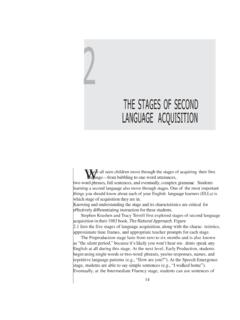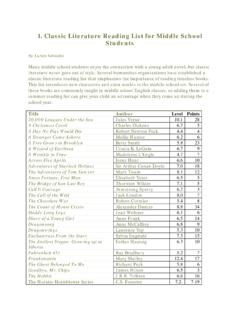Transcription of .(T - OM Personal
1 Y f !, 2.(T. I Know W hy the Caged Bird Sings MAYA A N G E L O U. Level 6. R eto ld by Jacqueline Kehl Series Editors: Andy H opkins and Jocelyn Potter RLRFANTA Contents page Introduction V. C hapter 1 G rowing U p Black 1. C hapter 2 T he Store 2. C hapter 3 Life in Stamps 9. C hapter 4 M om m a 13. C hapter 5 A N ew Family 19. C hapter 6 Mr. Freeman 27. C hapter 7 R e tu rn to Stamps 38. C hapter 8 Two W om en 40. C hapter 9 Friends 49. C hapter 10 Graduation 58. C hapter 11 California 63. C hapter 12 Education 71. C hapter 13 A Vacation 75. C hapter 14 San Francisco 87. C hapter 15 M aturity 93. Activities 100. /. Introduction In Stamps, the segregation was so complete that most Black children didn't really; absolutely know what whites looked like. We knew only that they were different, to be feared, and in that fear was included the hostility o f the powerless against the powerful, the poor against the rich, the worker against the employer; and the poorly dressed against the well dressed.)
2 This is Stamps, a small tow n in Arkansas, in the U nited States, in the 1930s. T h e population is almost evenly divided betw een black and w hite and totally divided by w here and how they live. As Maya A ngelou says, there is very little contact betw een the two races. T h eir houses are in different parts o f tow n and they go to different schools, colleges, stores, and places o f entertainm ent. W hen they travel, they sit in separate parts o f buses and trains. After the A m erican Civil War (1861 65), slavery was ended in the defeated S outhern states, and m any changes were made by the national governm ent to give black people m ore rights. However, as time passed, the South was left m ore and m ore alone and the state governments began to take control again.
3 Black and w hite people were segregated in many ways. Arkansas, like all Southern states, passed laws against m arriage or even close relationships between the races. Blacks were prevented from voting by having to pay taxes or pass difficult reading and w riting tests. By the early twentieth century, the inequality was as bad as in South Africa. Maya Angelou was not b o rn into this. H er parents lived in St. Louis, a city six hundred kilom eters to the north. There, the situation o f black people, though far from perfect, was m uch better. W hen she was three, though, M aya's parents parted, and she and her brother Bailey were sent south to live in Arkansas. This book is the story o f the early years o f Maya Angelou s life. She meets w ith racism in its worst forms.
4 Then, at the age o f eight, she is raped by her m other's boyfriend. She returns to Stamps but, w hen her m other moves to California, travels to jo in her. She sees her father again, and tries to drive him hom e from M exico w hen he is too drunk to move. It is a far from norm al way to grow up, but Maya Angelou survives, graduates from college, and sets out on the path to being the famous and im portant w om an that she is today. I Know W hy the Caged Bird Sings is the first o f five books that Maya Angelou wrote about her life. T he others are Gather Together in M y Nam e (1974), Singin' and Swingin} and Getting' Merry Like Christmas (1976), The Heart o f a Woman (1981) and A ll God's Children need Traveling Shoes (1986). She is also know n as a poet and an actress.
5 In the 1960s, the U nited States governm ent passed a num ber o f laws to end segregation in the South. However, the laws were passed in Washington, , and had little effect in Alabama, Georgia, and Arkansas. Lack o f action led to black protests on the streets, w hich were stopped w ith great violence by the police. T he struggle for change became know n as the Civil Rights M ovem ent. At the end o f the 1950s, Maya had moved to N ew York to w ork as an actress and she m et many artists and writers w ho were active in the m ovem ent. However, she soon left the U nited States because, like m any black Americans then, she was becom ing interested in her African history. She moved, w ith her son, at first to Egypt and then, in 1962, to Ghana. There she became friends w ith the black leader M alcolm X and returned w ith him to the to build a new civil rights organization.
6 B ut in February 1965, M alcolm X was shot dead. At this time the leader o f the Civil R ights M ovem ent was M artin Luther King. In 1963 a quarter o f a million people o f all races had m arched on W ashington where, from the steps o f the VI. Lincoln M em orial, King made his most famous speech. In it he talked about his dream o f racial equality: I have a dream that one day on the red hills o f Georgia the sons o f form er slaves and the sons o f form er slave owners will be able to sit dow n together at the table o f brotherhood.. O n April 4th 1968, on Maya A ngelou's birthday, M artin Luther King was m urdered in M emphis, Tennessee. It was because o f her g rief at his death that Maya w rote I Know W hy the Caged Bird Sings. T he title o f the book comes from the poem Sympathy , by Paul Laurence D unbar (1872-1924).
7 H e was the son o f escaped slaves and w rote about a bird in a cage w hich has beaten the bars until its wings are bruised. Its song is not a song o f joy, but a prayer for freedom. T he years after this were some o f Maya's best as a w riter and a poet. She w rote articles, short stories, poems, songs, and music for movies. She continued the story o f her life, produced plays, and gave lectures. She also w rote for television and acted on it. She m et the talk show host, O prah Winfrey, and became her friend and adviser. In 1981 she returned to the South and became professor o f Am erican literature at Wake Forest University in South Carolina. W hen Bill C linton became President in 1993 she read her poem , On the Pulse o f Morning , at the ceremony. Since then she has been busy as a highly-paid lecturer.
8 R ecently she has given up flying, and she travels to her lectures by tour bus because she is tired o f the problems o f being famous. Maya Angelou s story is the story o f a black girl and a black w om an's victory over racism. It is also the story o f the march to freedom o f African Americans. V ll ELEFANTA Chapter 1 Growing U p Black What you looking at me for? I didn't come to I hadn't forgotten the next line, but I couldn't make myself remember. O th er things were m ore im portant. W h eth er I could remember the rest o f the poem or not didn't matter. T he tru th o f the statem ent was like a w et handkerchief crushed in my fists. The sooner they accepted it, the quicker I could let my hands open and the air w ould cool them . What you looking at me fo r.
9 ? . The children's section o f the C olored M ethodist Episcopal Church was laughing at m y w ell-know n forgetfulness. The dress I w ore was light purple. As I'd w atched M om m a make it, putting fancy stitching on the waist, I knew that w hen I. put it on I'd look like one o f the sweet little w hite girls w ho were everyone's dream o f w hat was right w ith the world. H anging softly over the black Singer sewing m achine, it looked like magic. W hen people saw m e w earing it, they were going to ru n up to me and say, M arguerite [sometimes it was dear M arguerite'], forgive us, please, we didn't know w ho you were, and I w ould answer generously, N o, you couldn't have know n. O f course I. forgive you.. Just thinking about it made m e feel heavenly for days.
10 B ut Easter's early m orning sun had shown the dress to be a plain ugly one made from a w hite w om an's faded purple throwaway. It was long like an old lady's dress, but it didn't hide my legs. T he faded color made my skin look dirty like m ud, and everyone in church was looking at my thin legs. 1. I. W ouldn't they be surprised w hen one day I woke out o f my black ugly dream, and my real hair, w hich was long and blonde, w ould take the place o f the kinky mass that M om m a w ouldn't let me straighten? W h en they saw my light-blue eyes, they w ould understand why I had never picked up a Southern accent, or spoken the language like they did, and why I had to be forced to eat pigs' tails. Because I was really w hite and a cruel magician had turned m e into a too-big N egro girl, w ith kinky black hair, broad feet, and a space betw een her teeth that w ould hold a pencil.











